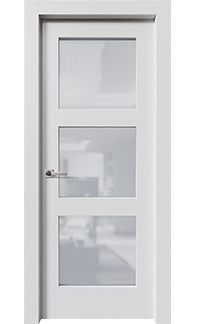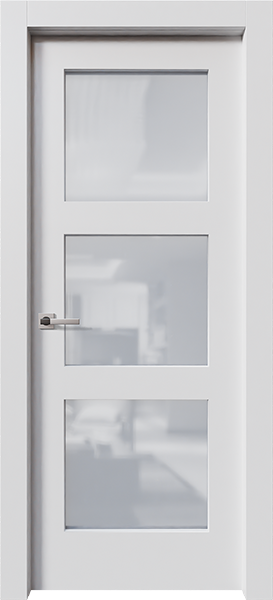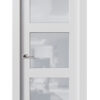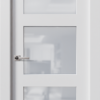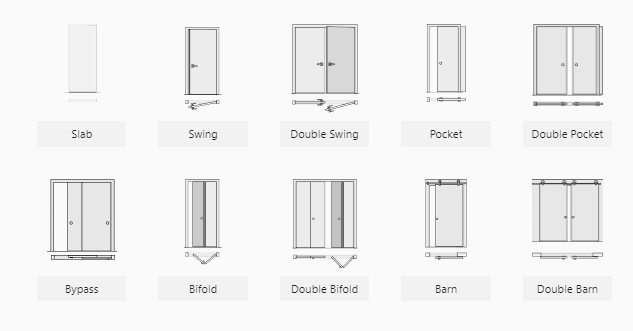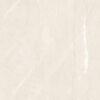Description
THE DOOR NAME ORIGIN – “SHAKER STYLE 3 EQ LIGHT LAMI GLASS”
This interior door model has a secret.
Don’t get me wrong, there’s nothing mysterious about its basic features and functions. It is, like all interior doors in this collection, a product of several technological breakthroughs achieved in this century. These have given our engineers and designers lots and lots of freedom, and our customers a great many new options as well as amazingly low prices.
Such as the “wrap” method, a combination of heat and pressure working on molecular level, which effectively fuses the finish with the surface, rendering the final product fade-proof, warp-proof, and scratch and moisture resistant. This is certainly a huge step forward from traditional finishing approaches, and it takes sound-proofing and thermal insulation qualities to a whole new level.
Nor is the hardware a big mystery. Like the Italian-made 3D-adjustable self-lubricating concealed hinges: what you see is what you get, i.e. easier than usual installation of your interior doors, no creaking ever, and the boundless joy of never seeing the pin, because, well, there is no pin. It’s elegant, it’s cool, it’s beautiful. But hardly mysterious.
Nor is there anything particularly mysterious about the Shaker movement, originating in the middle of the Nineteenth Century and quickly spreading westward from New England. They aimed for simplicity. They rejected all baroque and even some neoclassical features as a matter of principle.
The three equal-sized lites, however, come with a story.
Strictly speaking, this interior door is not really a French door, just a door with lightly laminated glass, no pun intended. That said, the design is certainly influenced by the history of French doors (you might want to check out the blog entry on the subject), and, as such, the number three isn’t just a random number here.
When Alexandre Dumas the Father, a novelist of some renown, began to conceive his celebrated masterpiece, what he seems to have had in mind was presenting his readers with three portraits – three men representing what back then was viewed as “typical Frenchmen”: a noble-minded aristocrat; a wily politician; and a good-natured, yet highly loyal, simpleton. One may debate the fact that these are quintessential French men, and one would be right: France is a large country with lots of people, and the number of French “types” is a good deal larger. True, but let us remember that Dumas was a romantic writer, and one of romanticism’s goals is to present an idealized and, at the same time, elegantly simplified, version of people and events.
Thus, the three “temperaments.”
Aristocratic: when the lead character of the novel asks Athos why he wouldn’t want to borrow a horse from the captain, the reply is truly aristocratic, combining arrogance and meekness: “My dear friend, when I have my own horses, I ride. When I don’t, I walk.”
Political: the one-time musketeer and later a priest and later still a plotter believes he is within his rights to use his gullible friend to help him achieve his ambitions, without telling the friend what really is going on.
Simple, loyal, and noble at the same time: the simpleton asks his friend why he got him involved. When the plotter admits he did it for his own selfish gain, the simpleton, looking astoundingly noble in his seeming foolishness, replies, with conviction (he isn’t clever enough to be sarcastic): “Oh. Now I understand. You did it for yourself. I have nothing to reproach you for. You needed my help, and I, remembering our old pledge, “All for one and one for all,” came to assist you. There’s nothing wrong with that.”
Romantic? Yes. Very dramatic, too. Just like this interior door. That’s the secret
FINISH: PRIMED
The advantages of this approach – of this type of interior door finish – are fairly obvious. Pick a color, any color that suits your projects best. Mix and apply. Re- coat whenever you feel it is necessary to do so. Touch it up. It gives you, the proud owner of these interior doors, complete freedom of choice, and the significant savings, especially where it comes to bulk orders, can be a true source of joy.
As Kurt Vonnegut mentions in one of his novels (Bluebeard, unless I’m mistaken … check it out when you get a chance), the thrill of laying on colors is a large part of the artist’s professional satisfaction. In other words, a keen pleasure.
When back in the remote past visual arts became a field dominated by professionals rather than hobbyists, the main problem of “just laying on paint” became obvious: you can’t.
The medium of choice back then was egg tempera, a permanent, fast-drying substance consisting of colored pigments mixed with a water-soluble binder medium, usually glutinous material such as egg yolk. Portraits and ornaments were executed in this medium, and the wood panel was the surface of choice. One of tempera’s interesting features is that it is not as easily absorbed by wood as other mediums. Some sort of primer was necessary, of course, but pretty much any substance that dried evenly could be used.
The drawbacks of tempera, or pintura al temple, as the Spanish call it, only became obvious with the advent of the Renaissance, when the leading representatives of the trade turned to oil (and interior doors suddenly became a great deal less crude, but that’s a story for another day).
Oil painting is the process of “painting with pigments with a medium of drying oil as the binder.” Commonly used types include linseed (highly preferable in art, though not necessarily in interior doors, mind you), poppy seed, walnut, and safflower.
Today, five hundred years later, it is safe to say that oil is more versatile than pintura al temple – by orders of magnitude. Specifically, the contrasts achieved through the former are much greater, the darks are far deeper, and three- dimensional, highly realistic images are much easier to achieve. Next time you visit a museum, take a closer look at pintura al temple portraits. All of them, without exception, come off as a bit “flat” as opposed to their latter-day counterparts.
Also, where glazing is concerned …
Glazing: a painting technique in which a transparent layer, with just a touch of pigment, is laid over a previously painted surface, allowing light to travel through the glaze and be reflected back off of the opaque layer below. Gentle shadows, subtle changes of color, smooth transitions – all these can be achieved through glazing, which was used by all artists up until the middle of the Nineteenth Century, when artist tubes were invented, revolutionizing the field, and other techniques began to be explored.
Tempera enthusiasts (it takes all kinds to make a world) will assure you that glazing is not just possible in pintura al temple but is actually the basis of the whole enterprise. Well, what are you going to do? They’re enthusiasts.
Anyway, la peinture à l’huile, as the French call it, re-introduced the ancient problem of most surface’s propensity to absorb dipingere, as the Italians call the stuff. Wood or canvas, it is all the same: you’re not going to get very far without a good primer.
Experiments were conducted, and soon rabbit skin glue emerged as the least expensive and most effective solution. It was easy to apply. It dried evenly. It made the application of the l’huile stuff on top of it a walk in the park.
There were drawbacks. Today, rabbit skin glue is considered to be a major cause of cracking by most modern conservators. (Remember, when you visited the Metropolitan Museum of Art – and did you see those interior doors? … some of them are quite something … – most “old masters” pictures are completely covered with a cobweb of cracks? There you go). Because the glue is hygroscopic, it continually absorbs moisture from the atmosphere, causing the glue to swell and shrink as ambient humidity levels change. Over many humidity cycles, this repeated flexing causes the brittle oily layers to crack.
To combat this problem, modern primers are made of acrylic materials which are guaranteed not to cause any damage to the dipingere. No bubbling, no cracks. Your interior doors are safe

